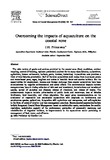Overcoming the impacts of aquaculture on the coastal zone

View/
Request this document
Date
2006Author
Page views
247Metadata
Perlihat publikasi penuhCited times in Scopus
Share
Abstract
The wide variety of goods and services provided by the coastal zone (food, medicines, nutrient recycling, control of flooding, typhoon protection) account for its many uses (fisheries, aquaculture, agriculture, human settlements, harbors, ports, tourism, industries). Aquaculture now provides a third of total fisheries production. Half of the total aquaculture yield comes from land-based ponds and water-based pens, cages, longlines and stakes in brackish water and marine habitats. But the opportunities for employment, income and foreign exchange from coastal aquaculture have been overshadowed by negative environmental and social effects. The environmental impacts include: mangrove loss, bycatch during collection of wild seed and broodstock, introductions and transfers of species, spread of parasites and diseases, misuse of chemicals, and release of wastes. The socioeconomic impacts include: privatization of public lands and waterways, loss of fisheries livelihoods, food insecurity, and urban migration. The paper gives recommendations on the attainment of responsible and sustainable aquaculture with emphasis on herbivorous and omnivorous species, polyculture, integration with agriculture and mangroves, and self-regulation in the form of codes of conduct and best management practices. Recommended approaches include holistic Integrated Coastal Zone Management based on stakeholder needs, mechanisms for conflict resolution, assimilative capacity of the environment, protection of community resources, and rehabilitation of degraded habitats, to improvements in the aquaculture sector pertaining to management of feed, water, and effluents.
Suggested Citation
Primavera, J. H. (2006). Overcoming the impacts of aquaculture on the coastal zone. Ocean and Coastal Management , 49(9-10), 531-545. https://doi.org/10.1016/j.ocecoaman.2006.06.018
Subject
Koleksi
- AQD Journal Articles [1215]

